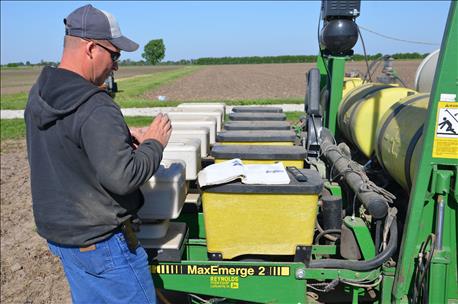
If you buy GMO corn, at least with certain GMO traits, you get a form in the mail, actually a packet of forms with more "legal-ese" than it takes to buy a house – almost. If you don't sign it, you don't get the corn. Don't complain to your seedsman. He'll tell you it's the tech provider. And the deal is sign or don't buy – then don't plant.
Related: Refer to seed tags before spraying fields
So you have to sign all these forms with all kinds of provisions, some of which actually relate to understanding how to take care of the product. Then you get the seed. If you're still buying in bags, it will have from one to a multitude of tags, depending upon which traits are in the corn.

Tough job: Pete Illingworth, planter operator at the Throckmorton Purdue Ag Center, had difficulty reading what was left of a seed tag ripped in two while being removed from the bag.
But one thing is sure to be the same – the tags are stitched into the bottom of the bag. The only way to read the tags is to remove them. And if you remove them, you will tear them into at least two pieces. There's no way around it.
Once they're in pieces, try reading and making sense out of the part that was near the stitching. It's nearly impossible.
So now you have high-tech corn with high-tech instructions and labels you can't read because they are attached with 60-year-old technology, more or less.
I've suggested alternatives: put it in a plastic pouch and glue it on the bag. That won't work because they could come off, or if the seed is held over, it would have an invalid tag on it. At least that's what seedsmen tell me.
I've suggested well, then, put the information that won't change, that's so important for me to read, inside the bag. No, that won't work because the first time a paper went into a planter box the farmer would be up in arms, especially if it was me who had the messed-up planter.
So then how do they get by putting coupons in cereal boxes and in dog food boxes and the like?
Calm down, Tom, it's not a big deal. So you say. I'll wager one of my prize lambs that would make good lamb chops that if farmers could afford to hire attorneys as sophisticated as big companies hire, the farmer's attorney would be suing the company for expecting him to read and understand a tag that he couldn't read unless he ripped it in two parts.
Related: Save Seed Bag Labels to Remember What's Planted Where
Seedsmen tell me to just not worry about it, and go read their Website instead, they have excellent information there. Sorry, but I don't have a smartphone screen big enough to let me read the screen in the field, which is when I want to read the tag – when it matters most. Not back in the dead of winter when I'm signing some form I can't make heads or tails of anyway.
To be fair, livestock companies do this too. I can't read feed tags either. I like to make sure the copper level is low because sheep can't handle much copper. You guessed it – by the time you get to the copper percentage, it's usually right in the crease sewn into the bag.
We put a man on the moon pushing 50 years ago. A farmer grew more than 500 bushels of corn per acre in 2014. Surely we can do better than put important information on a product in a way there's no way to read it even if you try. Surely!
About the Author(s)
You May Also Like




